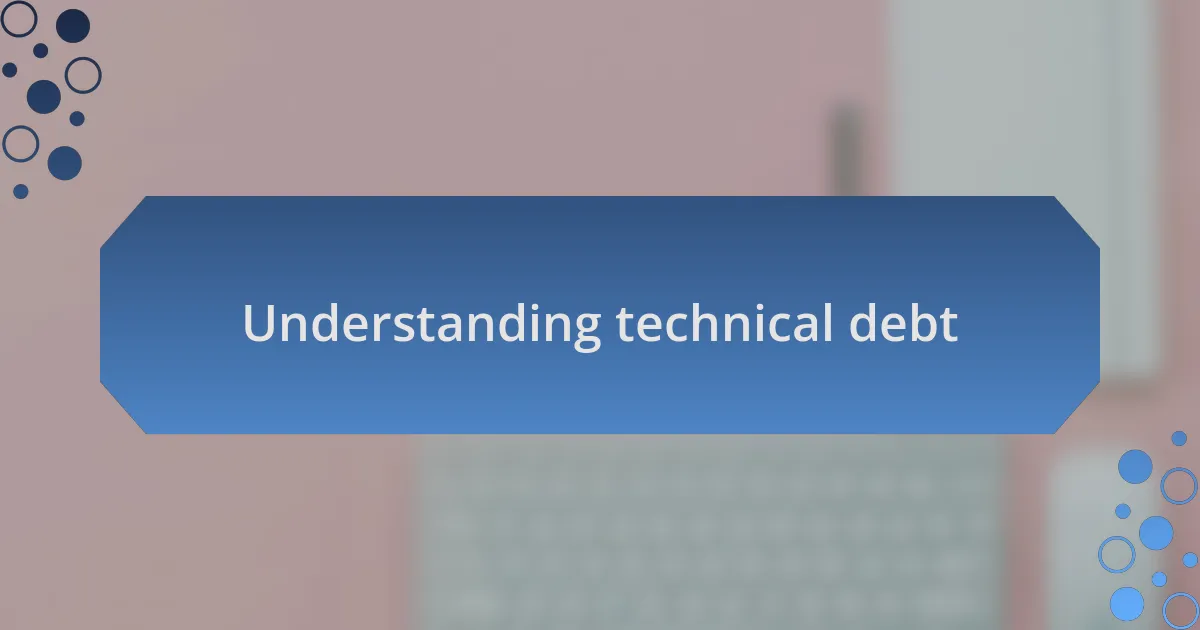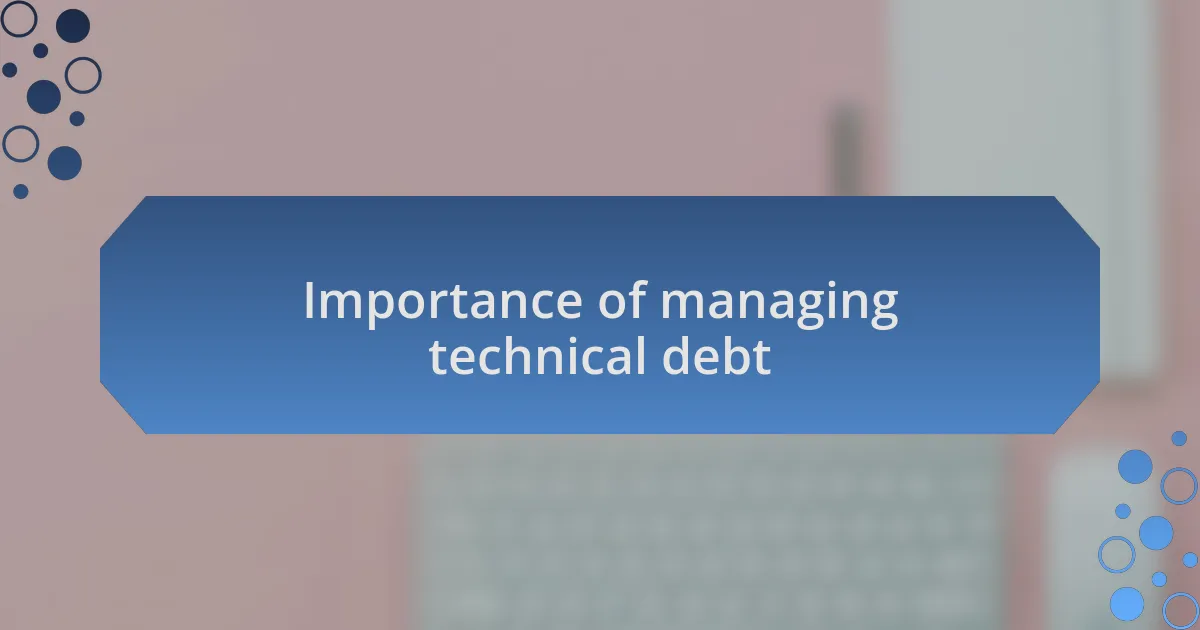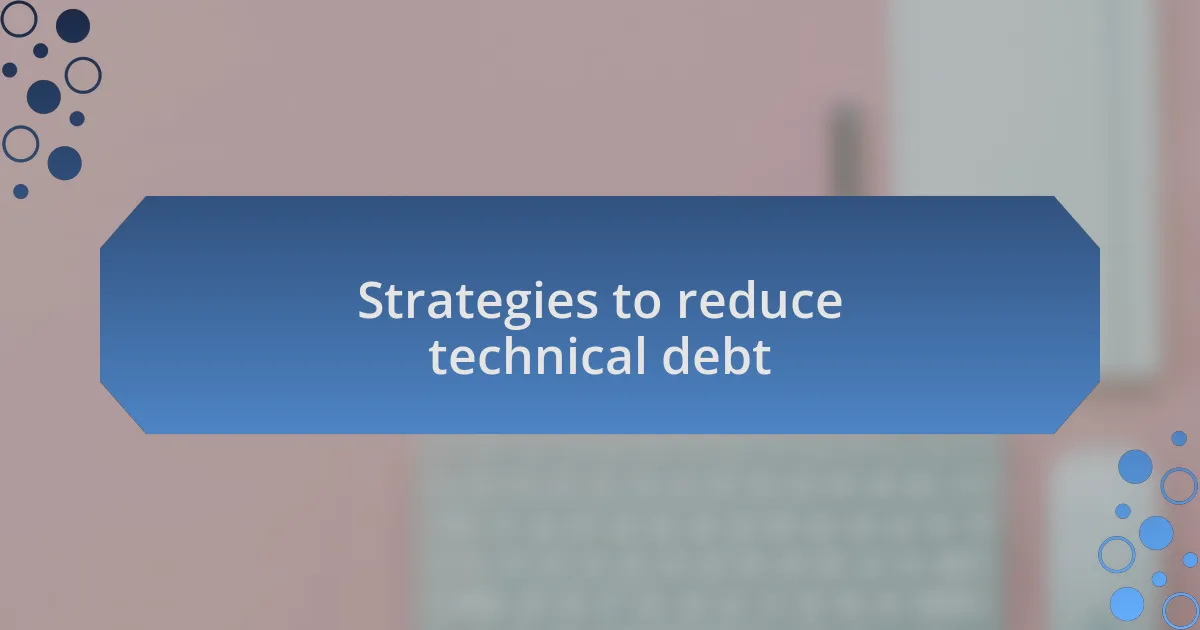Key takeaways:
- Technical debt, akin to financial debt, accumulates when short-term gains are prioritized over long-term stability, impacting team morale and productivity.
- Managing technical debt is essential for maintaining a project’s agility and innovation; neglecting it can lead to increased frustration and burnout among team members.
- Effective tools like JIRA and SonarQube, along with proper documentation, are crucial for tracking and managing technical debt, fostering transparency and shared knowledge within teams.
- Adopting agile methodologies, prioritizing debt in the development backlog, and establishing a budget for technical debt payback can significantly improve code quality and team morale.

Understanding technical debt
Technical debt is an unavoidable part of software development, much like financial debt that accumulates when we prioritize short-term gains over long-term stability. I remember a project where we rushed to release new features to stay ahead of competitors, disregarding the underlying architecture. In hindsight, that decision added layers of complexity that haunted us during every update.
As I navigated through those tumultuous waters, I often found myself asking, “What’s the cost of ignoring this issue now?” It’s a bit like skipping routine car maintenance; while it feels like saving time at the moment, the long-term consequences can lead to much larger issues down the road. I learned that even small patches of technical debt can morph into significant roadblocks if neglected.
Understanding technical debt also requires emotional resilience, as it’s often tied to team morale and project velocity. When team members continuously face challenges due to accumulated debt, frustration builds, and productivity wanes. I’ve had moments when the weight of that debt felt like a heavy cloud looming over us, affecting not just the codebase but the whole team’s spirit. Addressing technical debt isn’t just about fixing bugs; it’s about fostering a healthier, more productive work environment.

Importance of managing technical debt
Managing technical debt is crucial because, if left unchecked, it can significantly hinder a project’s agility and innovation. I recall a situation where our team continuously pushed out new updates to keep users engaged, but behind the scenes, we were building on a shaky foundation. When the time came to implement a pivotal feature, we discovered that the technical debt we had accrued meant it would take much longer than anticipated, stifling our competitive edge. How often do we sacrifice long-term progress for short-term relief?
The emotional toll of technical debt cannot be underestimated either. I vividly remember days when our team felt demoralized by constant firefighting instead of focusing on exciting new developments. It created a vicious cycle of stress and burnout that made it hard for us to maintain the enthusiasm that first drew us to the project. By tackling technical debt head-on, we could reinvigorate the team’s spirit and clarity.
Moreover, effectively managing technical debt speaks volumes about a team’s dedication to quality and sustainability. It strikes me how often we talk about creating great software but forget that maintaining it is just as important. When I started prioritizing the resolution of technical debt alongside new features, I noticed not only a boost in efficiency but also a newfound respect from the team. Are we not all trying to create something lasting?
![]()
Tools for tracking technical debt
When it comes to tracking technical debt, I’ve found that using dedicated tools can make all the difference. During one of my projects, we implemented a tool called JIRA, primarily known for issue tracking, but I discovered its capabilities to manage technical debt effectively. By creating custom fields and workflows, we highlighted areas of debt alongside our development tasks. It struck me how visualizing our debt helped the team realize its impact on our overall productivity.
Another effective tool I’ve encountered is SonarQube. This software not only assesses code quality but also provides a clear view of technical debt through metrics and visual reports. I remember presenting these insights during a team meeting; the shift in mindset was palpable. Everyone suddenly understood how reducing debt could enhance our codebase and, in turn, our end-users’ experience. Isn’t it fascinating how data can empower a team to take action?
Lastly, I cannot stress enough the importance of documentation in managing technical debt. Tools like Confluence have served as a great platform for me to document our technical debt discoveries and resolutions. I often encourage my team to jot down their experiences and insights, fostering a culture of transparency. Reflecting on this, I’ve come to see that teamwork and shared knowledge are vital in effectively tackling the challenges that technical debt brings. How well are we documenting our learning processes?

Strategies to reduce technical debt
Adopting agile methodologies can be a powerful strategy to reduce technical debt. I recall a project where we implemented short sprints focused on tackling specific areas of debt. This approach not only enabled us to address issues more frequently but also fostered a sense of accomplishment among team members. Have you ever noticed how quickly solutions can come together when teams focus on iterative progress?
Another practical strategy I’ve found effective is prioritizing debt alongside new features in the development backlog. In a previous project, we decided to allocate a percentage of our capacity explicitly for debt reduction. This decision was transformative; it created a shared understanding across the team that addressing technical debt is as critical as developing new functionalities. When everyone collaborates on this front, I’ve seen morale improve as team members feel like they are building a better future for our projects.
Lastly, establishing a “technical debt payback” budget has proven invaluable in my experience. By reserving a portion of our resources solely for this purpose, I was able to influence management to support our long-term vision. I often reflect on how hard it can be to balance immediate needs with future sustainability, but I’ve learned this dedicated focus directly pays off in code quality and team morale. Have you considered how a defined budget could change your approach to managing technical debt?

Prioritizing technical debt issues
To effectively prioritize technical debt issues, I start by assessing the impact each issue has on our software’s overall functionality. I remember diving into a project where some legacy code was causing frequent bugs. By addressing those critical pain points first, we were able to enhance user experience significantly, showcasing how targeted prioritization can transform a project. Have you ever felt that sense of relief when a persistent issue finally gets resolved?
Another method I’ve embraced is categorizing technical debt based on urgency and severity. This approach was especially useful during a particularly hectic launch cycle, where we had to distinguish between issues that could wait and those that could derail our efforts. It requires honesty and a clear assessment from the whole team, but I find that engaging everyone in this evaluation fosters a stronger team dynamic. How valuable is it to you when every team member has a voice in prioritization?
Lastly, I frequently consult with stakeholders to understand their perspectives on what technical debt burdens their experience the most. In one memorable instance, client feedback unveiled a UI issue we hadn’t prioritized but profoundly impacted user satisfaction. By integrating this feedback into our prioritization process, I witnessed not just improvements in our software but also stronger relationships with clients who felt heard. It really does make you wonder: how often do we overlook the voices that guide our prioritization?

Personal experiences with technical debt
There was a time when I underestimated the long-term effects of ignoring small technical debt issues. I recall a project where minor bugs accumulated over time, creating a sort of domino effect that led to significant functionality problems. Initially, I thought I was being efficient by postponing these fixes, but looking back, I realized that avoiding these small debts only made the eventual cleanup even messier. Have you ever found yourself in a similar situation where a small oversight escalated into a larger headache?
One challenging experience I faced was when I had to deal with a database that had several inefficiencies. As we scaled, performance began to lag under increased traffic. It was during this crunch time that I fully understood how technical debt could become a bottleneck. Addressing these database issues required a significant time investment, but it was essential for overall stability. Reflecting on that experience, I often ask myself, how can we preemptively tackle these problems before they become major roadblocks?
Engaging in team discussions about technical debt has been eye-opening for me. I remember one particular brainstorming session where my team shared their struggles with documentation. We realized that unclear documentation resulted in repeated errors and wasted hours for new team members. This shared acknowledgment created a collective commitment to improve our documentation practices, turning what once felt like an individual burden into a team responsibility. Don’t you think fostering such open dialogue can help transform how we view and manage technical debt?